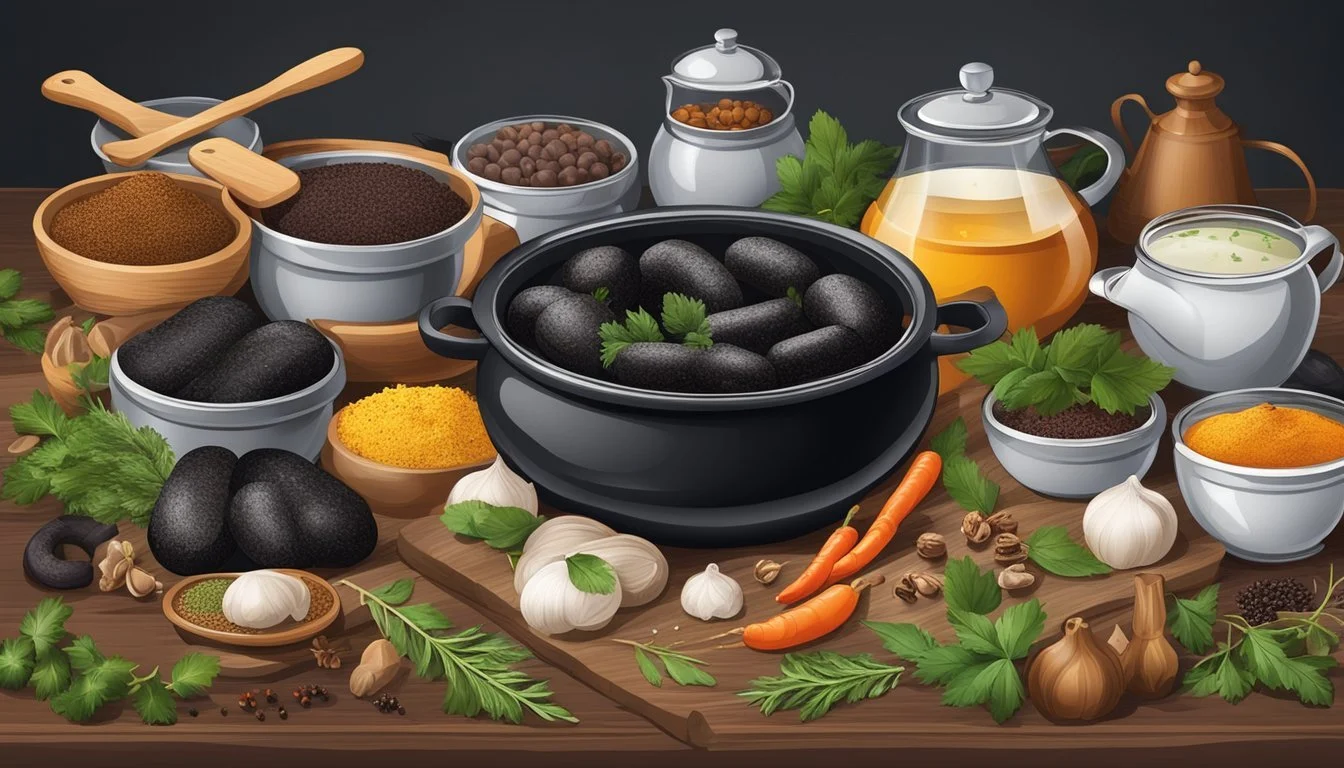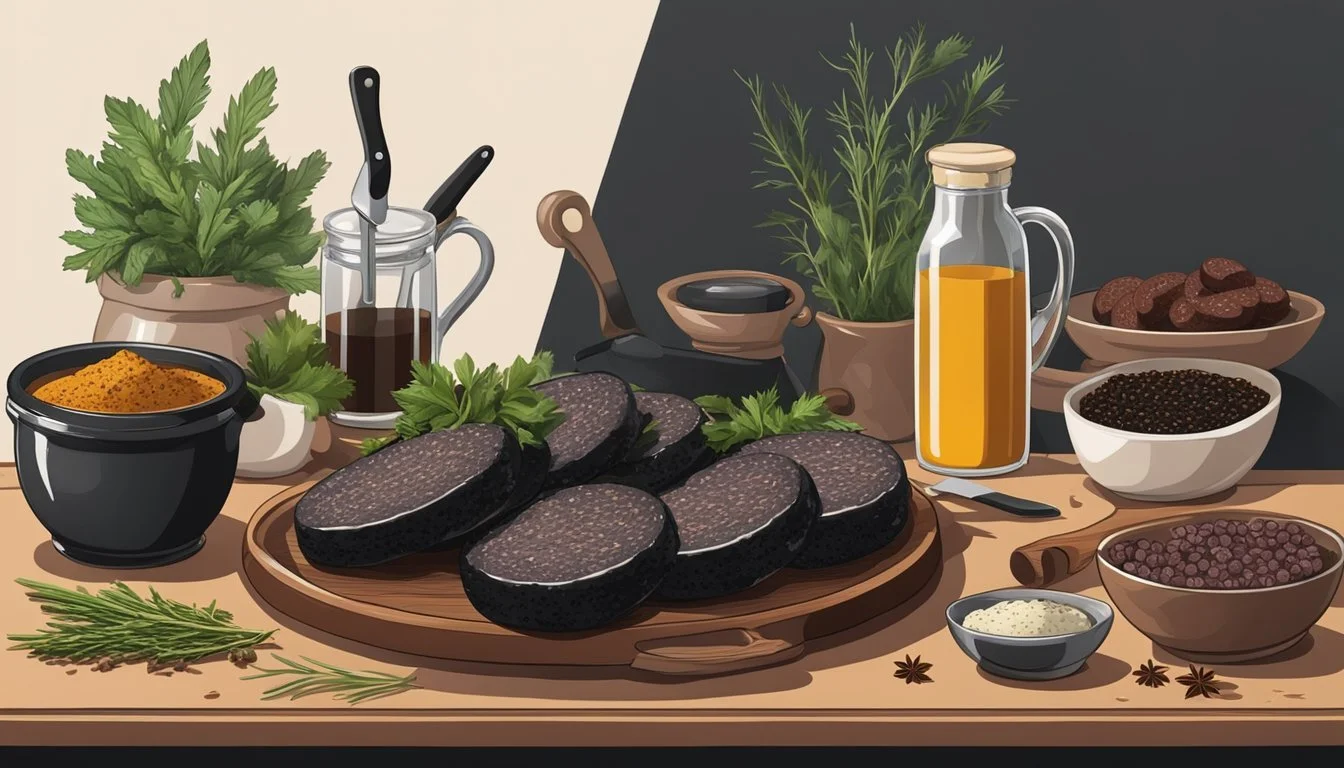Black Pudding
A Global Guide to Traditional Blood Sausage
Black pudding, a type of blood sausage, is a traditional savory dish deeply rooted in the culinary heritage of the British Isles. It is characterized by its rich flavor and dark color, resulting from the blend of animal blood, typically pork, with oatmeal or barley. The history of black pudding can be traced back centuries with references found in ancient texts, indicating its long-standing place on the breakfast tables and in the cuisine of Britain and Ireland.
The reach of this traditional dish extends beyond the British archipelago, sharing its fundamental aspects with variations of blood sausages found worldwide. This cultural exchange has led to the birth of different regional versions utilizing local ingredients while maintaining the iconic base of animal blood and a filler like cereal. The dish's nutritional content, alongside its unique taste, has secured black pudding's position as a beloved component in a variety of dishes, contributing to its enduring legacy as a global culinary staple.
Cultural Significance and Origins
Black pudding is a distinctive food item with deep historical roots and varied cultural expressions across the globe. It has evolved from ancient traditions and today is celebrated in various forms and names.
Historical Context
Black pudding, a type of blood sausage, is an established component of culinary history. Origins can be traced back to ancient times when it was a practical method of preserving blood without waste. Ancient Rome is often cited as one of the cultures that consumed a version of blood sausage, indicating its long-standing presence in human diets. This dish has been recorded in British cuisine since at least the 1400s, and references to similar foods appear in classical texts such as 'The Odyssey'.
Global Names and Variations
Across the world, black pudding is known by various names that often reflect local languages and cultural nuances. Among the many are boudin noir in France, blutwurst in Germany, and morcilla in Spain. While all share the fundamental ingredient of blood, regional variations include differing types of filler grains, meats, and spices, which give each version its distinctive taste and texture. For instance:
United Kingdom: Uses oats or barley as binders.
Spain: Incorporates rice in the mix.
Guyana: Rice and spices are used, known locally as Guyanese black pudding.
Cultural Impact and Celebrations
The black pudding holds considerable cultural significance in many communities. It is not just food but also a symbol of local tradition and pride. One notable event highlighting its cultural value is the annual World Black Pudding Throwing Championships held in Ramsbottom, England, which garners significant attention and participation. Black pudding is also a staple in traditional breakfasts in the British Isles, reflecting its integral role in the region's food culture.
Ingredients and Preparation
Black pudding is a traditional dish with its roots deep in culinary history, known for its distinct ingredients and versatile preparation methods.
Main Components
The main components of black pudding include blood, typically from pork, and a binding agent such as oats or barley. Fat, often in the form of suet, is another essential ingredient. These ingredients are encased in a casing, usually from the intestines of the animal.
Blood: Pork or beef (critical for texture and color)
Grains: Oats or barley (for binding and bulk)
Fat: Suet or other animal fats (for richness and flavor)
Casing: Natural or synthetic (to hold the sausage shape)
Seasonings and Flavorings
Seasonings and flavorings are added for taste and can include a variety of onions, spices, and herbs. The specific seasonings used can vary widely, each lending its own regional flair to the dish.
Onions: Often included for their sweetness and depth of flavor
Herbs and Spices: Can range from thyme and marjoram to exotic spices, tailored to regional tastes
Cooking Methods
Black pudding can be prepared using several methods, including boiling, frying, baking, or grilling, each method giving a different texture and flavor profile to the sausage.
Boiling: Often the first step in cooking, where the pudding is gently poached
Frying/Baking/Grilling: Used to create a crisp exterior and can be chosen based on the desired final texture and flavor
Nutritional Profile and Health Benefits
Black pudding, a traditional blood sausage, has garnered attention for its dense nutritional profile and potential health benefits. The following subsections provide specific details on its nutritional content, dietary advantages, and considerations to keep in mind.
Nutritional Content
Black pudding is rich in protein, an essential nutrient for muscle growth and repair. Its significant iron content is important for oxygen transport in the body. Additionally, it typically contains vitamins such as B12 and B6, alongside zinc, which supports immune function. A breakdown of key nutrients per typical serving is as follows:
Iron: Crucial for blood formation and function.
Zinc: Aids in immune response and healing.
Protein: Supports muscle maintenance and growth.
Fat: Utilized for energy; varies depending on preparation.
Vitamins B12 and B6: Important for neurological function and energy metabolism.
Dietary Benefits
Integrating black pudding into one's diet can contribute to:
Meeting daily protein requirements.
Enhancing iron intake, which may benefit individuals with anemia or those at risk of iron deficiencies.
Providing a source of B vitamins and zinc, both key to maintaining good health.
The presence of oats or barley in black pudding also offers a source of fiber, contributing to gastrointestinal health and satiety.
Considerations and Risks
When considering black pudding as part of a diet, one should also be aware of:
Fat content: Varieties high in saturated fat should be consumed in moderation.
Sodium levels: Some recipes have significant sodium, which can impact blood pressure.
It is essential to balance the intake of black pudding with other nutrient-dense foods and to be mindful of individual dietary needs and restrictions. Those with health conditions or specific dietary concerns should consult healthcare professionals before making dietary changes.
Culinary Uses
Black pudding is a versatile food item, traditionally served as part of a hearty breakfast but also adapted into various contemporary dishes.
Traditional Meals and Pairings
Black pudding is commonly featured in a full breakfast, a substantial breakfast meal that includes a variety of components such as eggs, bacon, and often mashed potatoes. It is served in thick slices and can be fried or grilled to enhance its rich, savory flavors. In Ireland, black pudding may be paired with another traditional dish, haggis, especially during celebrations like Burns Night. In England, particularly in Manchester, the Manchester egg—a pickled egg wrapped in black pudding and sausage meat, then coated in breadcrumbs and deep-fried—is a local delicacy. They may also serve it boiled with a splash of vinegar.
Modern Adaptations and Fusions
Chefs have been known to crumble black pudding and use it to add depth to contemporary recipes. It's used as a crispy topping for dishes, adding both a rich flavor and a satisfying texture. Black pudding has found its way into modern Yorkshire pudding recipes, elevating traditional Sunday roasts with a punch of umami. Fusion cuisine also sees black pudding incorporated into various international dishes, creating new experiences while respecting its traditional roots.
Regional Specialties and Delicacies
Black pudding, a variety of blood sausage, is a regional specialty with distinct versions found around the globe. Certain locales have elevated it to the status of a delicacy, embedding it firmly in their culinary heritage.
United Kingdom and Ireland
In the United Kingdom and Ireland, black pudding is a celebrated part of the traditional breakfast. Stornoway Black Pudding from Scotland is one of the most famed, boasting Protected Geographical Indication (PGI) status. It's made from beef or pork blood, suet, and oatmeal. Regional variations within the UK and Ireland reflect local tastes and cooking traditions. For example, in Ireland, black pudding often features alongside white pudding, which contains no blood but includes meat and fat.
British Food
Black pudding: Commonly includes pork blood, fat, and oatmeal or barley.
Stornoway Black Pudding: Protected recipe, distinctly Scottish, using local ingredients.
Europe and Beyond
Across Europe, various countries have their own interpretations of blood sausage. In France, boudin noir is a staple, often containing cream and onions, providing a different texture and flavor profile from its British counterpart. Spain's morcilla opts for a spicier approach with paprika and other seasonings, while Germany's blutwurst traditionally includes chunkier pieces of meat and fat.
European Variations
France: Boudin noir — Includes cream and onions.
Spain: Morcilla — Characterized by its use of spices and rice.
Germany: Blutwurst — Recognized by its hearty chunks of meat and fat.
Moving beyond Europe to Korea, soondae stands out with its use of glass noodles and a wide array of offal. Each blood sausage variety reflects the dietary preferences and agricultural practices of the region where it is produced.




